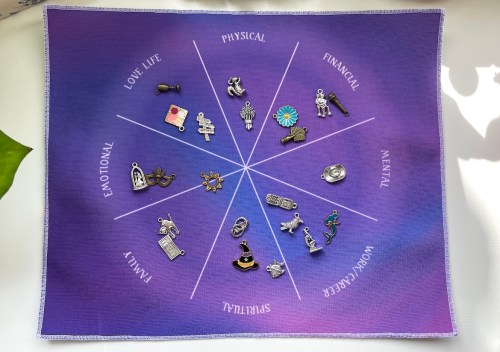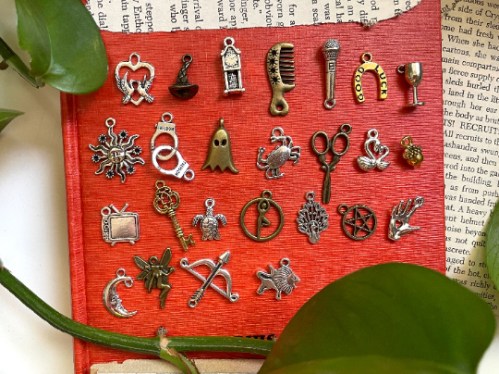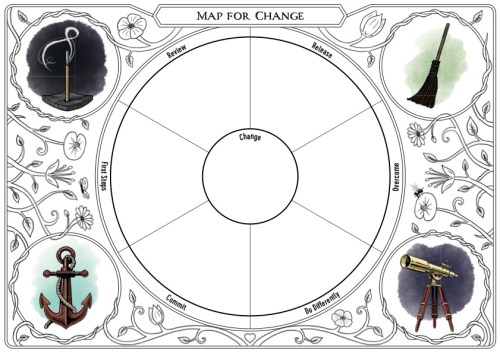Our editors independently select these products. Making a purchase through our links may earn Well+Good a commission
Everything You Need To Know About Charm Casting, the Divination Practice That’s as Pretty as It Is Powerful
Experts reveal tips on charm casting, the divination practice that's as pretty as it is powerful. Learn why and how to start charm casting.

For ages and across cultures, people have sought ways to interpret the world around them. Divination, or tapping into your spiritual and intuitive side for guidance, is one way to do this. Think about why tarot cards, dream interpretations, pendulums, and even astrology are popular—these tools are ways to look inside ourselves for guidance, and make sense of our surroundings. One pretty and powerful way to do so is through charm casting, or using the meanings associated with charms (yes, like your bracelet) to draw conclusions about what’s going on in your life.
Experts in This Article
spiritual advisor, tarot reader, and crone
owner of Charmco
mystic and author of Charm Casting
tarot reader and owner of the metaphysical shop Emerald Lotus Divination
Ever begged your parents for a charm bracelet, or worn a pendant around your neck that holds special significance to you? Humans have assigned meanings to ornaments like charms for thousands of years, but lately, one method of doing so called charm casting has been in the spotlight. Videos tagged “charm casting” have amassed 22.9 million views on TikTok (and counting). What’s old is new again, eh?
Read on for expert guidance for everything you need to know about charm casting, including its origins and how to get started.
What is charm casting?
In essence, charm casting is a way of gaining insight into your life by asking a question (or questions) then looking to the unique meaning of charms for answers. “It’s a form of divination where you assign individual charms a meaning,” explains Reid, tarot reader and owner of the metaphysical shop Emerald Lotus Divination. The meaning of the individual charms, whether pulled individually from a bag or box or tossed onto a casting mat marked with prompts, is what you use to answer your question and draw conclusions about what’s coming next for you.
“It’s a form of divination where you assign individual charms a meaning.”—Reid, owner of Emerald Lotus Divination
The exact origins of charm casting are unclear, but it draws from traditions present in many cultures for thousands of years. Evidence shows that divination rituals in general have appeared in various cultures throughout the ancient world, such as in ancient China, Greece, Mesopotamia, and the Roman Empire. These rituals took various forms throughout history and often made use of different objects, like stones, shells, bones, and more—the building blocks of modern charm casting. For example, Yoruba people in West Africa cast cowrie shells and drew meaning about the future based on their positioning, while Ancient Egyptians assigned meaning to objects like amulets and used them to bring good luck and fortune and to protect against disease and despair.
Charm casting also may have origins in osteomancy or bone divination, says Rebecca Anuwen, mystic and author of Charm Casting. This practice sought to find meaning from throwing bones and interpreting their positions. “Divination has been around as long as humans have and we’ve always looked outside ourselves for answers and signs from the universe,” she says. “Just as our ancestors did, we’re looking for guidance and a way to find meaning, insight, or clarity about something.”

Exactly what insight one draws from charm casting is an experience unique to the caster, because charms symbolize something different to each person. “As opposed to tarot or oracle, which have a defined set of meanings, charms are whatever you want them to be,” says Diana Frajman, tarot reader, spiritual guide, and crone. For example, for one person a charm shaped like an apple could signal vitality and learning, while for another it represents a poisonous fruit or temptation. That’s the beauty of charm casting—it’s whatever you want it to be. Maybe a skull and crossbones represents adventure, but for someone else it could mean treachery.
Throughout history charm casting has mostly been used in spiritual and religious practices, says Anuwen, but modern charm casting practices are much more personalized. Each caster’s method and tools may be slightly different. “Modern charm casting is often more intuitive and reflective of the charm caster’s personal beliefs and experiences,” she says. This means the possibilities for interpretation—and opportunities to look inward for guidance—are endless. Plus, the chance to connect with your inner self, albeit one that calls on you to make specific interpretations and draw meanings from visually pleasing objects, can be a helpful speed bump in a world that can feel like it never stops. “[It’s] a fun and insightful activity that brings you closer to yourself, offering a refreshing break and much-needed clarity in our ever-busy world,” she says.
How to start charm casting
1. Assemble your charm collection
To start charm casting, you need some objects. They don’t even have to be traditional charms that you find at the jewelry or craft store. You can simply look around your house for objects like buttons, shells, marbles, thimbles, or even paperclips, say all three experts, and assign a unique meaning to each. Reid advises starting with at least five (although says you can have as many as you want).
Pick objects that resonate with you and represent different happenings in your life. “It depends on what’s going on in your life, but you want to start thinking about something that represents those areas of life that often come up,” says Anuwen. For example, if you’re in a phase of life where you’re very focused on your career, you might want to have some charms that represent growth, momentum, stagnation, and/or success.
Be sure to pick some charms that represent both positive and negative happenings for the most complete readings. In this case, you don’t want only sunshine and rainbows—make sure you have some symbols for life’s challenges, too. That way, you gain insight into all facets of life.
Depending on how you approach charm casting, you might find yourself adding charms to your collection that represent important figures in your life. For example, you could have a charm to represent each family member or friend; you can cast these charms on a mat and see what’s in store for each of these people, including yourself. For your personal charm, pick a symbol that resonates with you. For Anuwen, this is a bejeweled crown; Reid has an Alice in Wonderland charm that represents her during castings.

Once you have your charms, spend some time thinking about what each means to you and what each symbolizes. If it helps you remember your associations, you may write the charms and meanings in a notebook to reference later. If you’re not sure where to start or are looking for ideas, Lisa Feldkamp, owner of luxury charm company Charmco, says these are some common meanings of popular charms:
- Sun: Life, light, vitality, understanding
- Moon: Internal feelings, emotions, introspection
- Heart: Romantic love, desire, passion, affection, courage, empathy
- Arrow: Direction, initiative
- Bow and arrow: Power, amassing strength
- Apple: Learning, curiosity, knowledge, wisdom, health, wellbeing, nourishment
- Cross: Faith, spirituality, forgiveness, salvation
- Skull: Fleeting nature of life, death, conflict, embracing present
- Key: Power, discovery, unlocking a mystery, opportunity
- Clock: Time, wisdom, embracing the present
- Lightning bolt: Creativity, innovation
- Star: Achievement, guidance/direction, dreams, expansion
- Sword: Protection, strength, power, aggression
- Tree: Growth, evolution
- Rainbow: Pride, hope, peace, transformation
- Evil eye: Protection, luck
- Wishbones, clovers, horseshoes: Luck
- Shell: Resilience, regeneration
- Mermaid: Beauty, enchantment, fantasy, power
- Mushroom: Personal growth, nature, medicine
2. Start small with a single charm, or cast your charms onto a casting mat
Once you have your charms assembled, it’s time to start casting. There isn’t any right or wrong way to charm cast, says Reid. “You can make it as simple as you want with only a couple of charms, or more complex with hundreds.” But having infinite options is a bit overwhelming, so we’ve provided a few places to help you get started.
Pulling a single charm: Much like a one card tarot pull, a single charm reading involves randomly selecting one charm from your collection and using that as your guide. This is a great way to start assigning meaning to your charms and understanding what each symbol means. “You pull one charm for yourself as anchoring and guidance for the day,” says Anuwen.
Start by asking a simple question, whether specific or general. “You could pull one charm to represent your mind, body, and spirit,” says Reid. Anuwen likes to ask: “What do I need to know today?” Or you could say, “What do I need to know about my love life?” and then select a charm at random. For example, perhaps you draw an arrow after asking this question. If you associate arrows with growth, you might take this to mean it’s time to spend some extra energy thinking about your direction.
Casting multiple charms on a casting mat: If you want more in-depth guidance, use a casting mat, which is a surface that can guide your charm casting. Casting mats typically are divided into segments that reflect a specific theme (for example, the change-themed map in the image below, which has sections labeled “First Steps,” “Release,” and “Overcome”) or that generally correspond to different areas of one’s life.
You can purchase a casting mat or create your own by dividing a piece of paper into segments and then labeling each area you want to explore. You could divide a surface in thirds and write “past,” “present,” and “future,” suggests Reid, or you can divide each segment into specific realms, for example: “career,” “travel,” “love,” “self,” and “family.” If you’re doing this method, you don’t need to ask a question because wherever the charm lands is the message, she says.
To use a casting mat, decide what you’re hoping to gain (for example, are you after clarity, or do you need to make a choice?) and randomly select a handful of charms. “This is a personal thing, but most people will have the charms in their hand or a small container and will shake them just to give them a little bit of life, like you would before rolling a dice,” says Reid. She says she typically closes her eyes or looks straight ahead before letting them gently fall on the mat.


3. Reflect on what the charm casting means
Once the charms are on the mat, Reid says she recommends starting with the clearest association. Perhaps you use the above casting mat for change and find a heart charm lands in the “commit” section. This could be a straightforward message that it’s worth committing more attention to your love life, or that you should commit to a romantic relationship that’s been mostly casual. From there, work through what’s on the board and draw connections to the charm’s symbolism and placement on the mat. Repeat the process as often as you want.
After you charm cast, it’s key to take the next step to connect what they casting means to your life. This is the step that provides the chance for insight. Reid recommends writing down what happens so you have a record of the lesson each charm gave you. “By writing them down, you’re really able to go back and reflect and it can be really helpful to record it,” she says.
Look out for how the symbolism you saw appears in your day, and try to reflect on what the casting meant. Try to challenge yourself. “If you’re constantly reading and only seeing what you want to see, it can be troublesome because you’re just perpetuating the ideas you already have,” says Reid.
Do’s and don’ts of charm casting
Do: Trust your initial intuition
Don’t second guess yourself about the conclusions you draw from the charms you cast. Remember that the point of this is to find answers for yourself, so trust your thinking. “The most important thing isn’t what the charm actually tells you, it’s how you receive that message,” says Anuwen.
Don’t: Trust the charms 100 percent
Remember that like anything, nothing is necessarily predictive or exact, which is why Reid recommends not reorienting your life and actions based on what the charms say. The charms can provide insight into what’s happening in your life, but don’t allow them to disorient or scare you. For example, drawing a charm that points to strife doesn’t automatically mean a relationship or friendship is doomed. “It’s important to keep perspective and recognize that it’s not a be-all and end-all,” she says. Charm casting is just one way to introspect further and gain a bit of insight into oneself—it shouldn’t cause stress or anguish, even if you pull charms that have a less positive association.
Do: Take it slowly
Avoid using too many charms in your initial readings or making them too complex, all the experts advise. Start with a smaller number of charms you like and assign meaning to rather than using more and having to sift through all of them. Do what’s manageable and fun.
Don’t: Think there’s a right or wrong way to do it
Ultimately, whatever method and manner you use to charm cast is right for you if you say it is. Don’t get tripped up thinking you’re not assigning the correct meaning to charms, or that you have to use a specific shape if you don’t want to, or that you have to do a charm casting every week—Anuwen, Frajman, and Reid all say that the right way to do this is up to you. “The beauty and challenge of [charm casting] is you’re asking to trust yourself,” says Anuwen.
Sign Up for Our Daily Newsletter
Get all the latest in wellness, trends, food, fitness, beauty, and more delivered right to your inbox.
Got it, you've been added to our email list.








